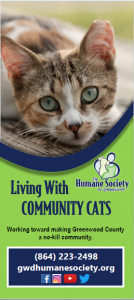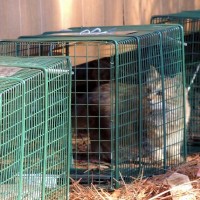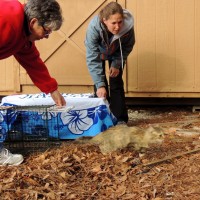What is a Community Cat?
A community cat is an outdoor cat that is unowned and free-roaming. This consists of adults, kittens, feral, strays, and friendly cats. These cats typically live together in what is called a colony. They typically choose their territories because of the availability of a food source and shelter. They in turn repay the favor of this advantageous set-up by keeping additional cats from moving into the neighborhood as well as controlling rodent populations for their human neighbors.
In Greenwood county alone, there are an estimated 11,500 homeless cats which includes both feral and stray cats in the community. A feral-neighborhood cat is an under-socialized, domestic cat who has been born outside or has been outside long enough that he/she distrust humans. Because of their deep-seated fear of humans, these cats are not candidates for an adoption program. Stray cats are socialized cats that are lost or have been abandoned. Both feral and stray community cats can live long and healthy lives outdoors but need support from dedicated caregivers for spay/neuter, food, water, and winter housing.
What is the answer to community cat control?
Community Cat Projects, which include TNR and Barn Cat programs, are life-affirming and allow people to help animals in need by controlling the community cat population. TNR saves the lives of community cats. Feral cats are not suitable indoor pets so once brought into the shelter they are not candidates for adoption. TNR gives us the option to allow them to live out the rest of their lives in an environment that they have always known and prefer. It also has the added benefit of the following:
- Cats can no longer reproduce allowing the colony to have the potential to decline in size over time.
- Spaying and neutering greatly reduces nuisance behavior such as fighting, yowling, and other behaviors associated with mating.
- Once male cats are fixed, the foul odor associated with them marking their territory disappears and their drive to mate decreases their need to roam making them less visible.
- Colony cat number decrease which in turn leads to healthier cats, less sickness, and decreases the spread of feline disease.
- NO MORE KITTENS!
- Rodent control is maintained by the cats’ continued presence.
- Long tern cost savings for shelters due to decrease in cat intake.
These programs also attract more volunteers, funding, and other resources for shelters. For these reasons, more and more municipalities and shelters are supporting TNR and developing their own programs. Most communities are seeing a dramatic drop in cat intake and euthanasia at their local shelters as a direct result of TNR and other spay/neuter programs. In the Northeast and Northwest, they are actually importing kittens from other regions due to shortages! Today’s reality of millions of unowned cats living on our streets is changing for the better and TNR is a big part of making that happen.
What is TNR?
Trap-Neuter-Return, or “TNR,” is the most proven humane and effective method known for managing feral and stray cats. Through TNR, community cats are humanely trapped and brought to a veterinary clinic. Once at the clinic, they are spayed or neutered, given the proper vaccinations (rabies, FVRCP), and given a mandatory ear-tip universally symbolizing that the cat has been altered and can no longer reproduce. After they’ve recovered from their surgeries, the cats are returned back to their original territory where a caretaker provides regular food, water, and shelter.
Kittens or friendly stray cats that are trapped will be removed and put into a foster home or put up for adoption when resources are available.
In certain situations, such as when the area that the cat has been trapped at is unsafe or the cats are being threatened with mistreatment, the cat will be placed in a barn home through the Barn Cat Program when available.
Why outdated control methods don’t work to solve the community cat issue?
The estimated number of community cats in the U.S. is in the tens of millions. Unfortunately, many communities still choose to control populations using outdated methods even though these methods have been proven to be ineffective. For decades, the traditional practice of community cat control was to trap and remove cats with the outcome usually being euthanasia. Most community cats who end up in shelters make up a large percentage of cats euthanized throughout the country every year. The current overpopulation of free-roaming community cats in the U.S. speaks loudly about the failure of that approach. Below are listed reasons why trying to eradicate cats from the environment doesn’t work:
- Too many cats and not enough animal control resources.
- Removing one group of community cats where they are being fed and given shelter only allows for another group to take its place creating a vacuum effect.
- Resistance from colony caretakers creates issues with capture.
- Most of the public does not agree with euthanasia
- Feeding bans and laws regulating cat owners have failed to make a difference.
The ASPCA endorses Trap-Neuter-Return-Monitor (TNRM) as the only proven humane and effective method to manage community cat colonies (ASPCA.org).
How is the Humane Society of Greenwood helping the community cat population?
The Humane Society of Greenwood has started is own Community Cat Program that encompasses both Trap-Neuter-Release (TNR) and Barn Cat Programs. The Community Cat Program relies heavily on its dedicated volunteers as they are the ones that go out and assess, trap, and care for these community cat colonies. Currently, we have started managing colonies that have been brought to our attention via the public. This program is expected to grow due to the need in Greenwood County. The HSOG greatly appreciates the support and aid of the community continuing our efforts in providing a humane solution to the community cat situation.
How can you help?
DONATE: This program relies heavily on the support of the community. Your donation will go towards the:
- Purchase supplies for TNR such as: humane traps, food, tarps, etc.
- Pay veterinarians/clinic who provide spay/neuter services, vaccinations, and ear tip
- Care of kittens/friendly cats that will be put up for adoption through the TNR program
- Emergency medical treatment of TNR cats
- Acclimation housing and supplies for cats needing to be rehomed through the HSOG Barn Cat Program.
VOLUNTEER: We are always in need of volunteers to help trap community cats for TNR. Classes and detailed instructions will be provided. Record keeping, community education, grant writing, participating in fundraising events, and maintaining equipment are others way that volunteers can help with the TNR program.
FOSTER: Our goal when doing TNR would be to place kittens and friendly cats into a foster home for rehabilitation. However, this can only be done if fosters are available. Fostering saves the lives of two for the price of one.
Below are site links for more comprehensive TNR information and educational materials. Educating the public is crucial to debunking the long-held belief that widespread euthanasia of feral cats is a solution. If you would like to be involved in local TNR efforts, email us and follow us on Facebook for announcements of upcoming workshops and volunteer opportunities.
 Download the TNR brochure by clicking on the banner to the left.
Download the TNR brochure by clicking on the banner to the left.
Spay/Neuter Services for Feral Cats
Let us help you stop the cycle of feral cat overpopulation!
Special priced spay/neuter services are available for feral and outdoor only community cats through our transport program with Animal Allies Spay/Neuter Clinic. For $45 cats will be spayed/neutered, vaccinated against rabies, FVRCP and receive a mandatory ear tip. Call (864) 538-0843 or email clinic@gwdhumanesociety.org for dates and details.
Humane Live Release Traps
Live release traps are available for Trap Neuter Return use for a refundable* cash deposit of $50 each. Up to two traps can be borrowed for one week at a time. Please visit the Spay/Neuter Clinic at 2820 Airport Rd, Greenwood, SC, Monday through Thursday 12:00 to 5:00 pm, for trap pick up and instructions.
* Traps must be returned in the same condition as they were borrowed, clean and in working order.
Resources
 Download Neighborhood Cats TNR Handbook
Download Neighborhood Cats TNR Handbook
(Excerpt) “If we keep ‘em in a cage, at least they’ll be safe.” This
has been the reasoning of numerous well-meaning cat
rescuers in the past. Surely the operative words here are “at
least” for we would have to admit that, for an animal or a
young child or any of us, a lot more than safety is required
if anything resembling a normal, healthy life is our goal.
Happily, there is a better way, a veritable win-win situation.
For feral cats, TNR (Trap-Neuter-Return) is the answer.
Links
Introduction to Feral Cats
Trap-Neuter-Return (TNR) is a strategy for improving the lives of feral cats and reducing their numbers.






